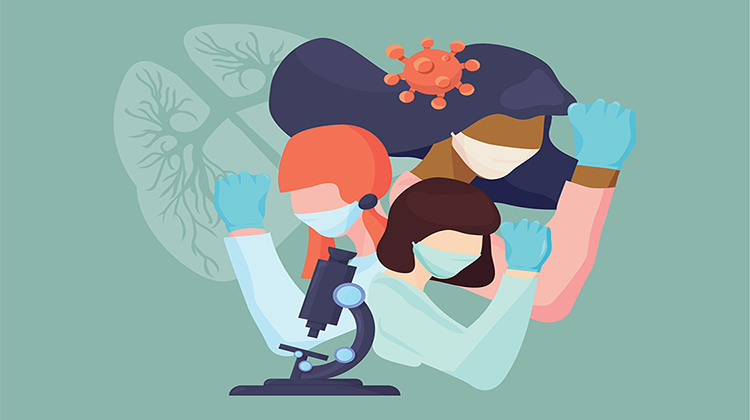Women in STEM with Avideh Nazeri
Posted: 15 November 2024 | Avideh Nazeri (Novo Nordisk) | No comments yet
Avideh Nazeri, Vice President of Clinical, Medical and Regulatory for Novo Nordisk UK, reflects on her journey through the world of STEM, highlighting the resilience and determination required to overcome biases and challenges along the way. She discusses how perseverance, collaboration and independent thinking have shaped her career, and offers advice for young women looking to make their mark in the fields of science and technology.


Can you tell us about your journey in the field of STEM and the challenges you encountered along the way?
Reflecting on my career, I did not initially recognise it as a journey. My entry into science during my childhood was almost unexpected, sparked by an inspiring teacher, as is often the case. Initially, I wasn’t the strongest student, but my perseverance compensated for what I lacked, which would serve me well throughout my career in STEM.
Science is inherently competitive, a reality that can be daunting for newcomers, and one which is paradoxical, given the field’s broad and inclusive intent. Yet, competition pushes us to continually elevate our research standards, posing a challenge but also inspiring us to excel further and to face the difficulty of dealing with setbacks. These obstacles necessitate resilience and the ability to embrace failure, which not everyone can manage easily.
I found that a few years into my career, the biggest challenge was to stand out among the top professionals in my field. Transitioning into industry marked a significant shift in that mindset and in my personal growth. The focus moved from individual pursuits and achievements to collective efforts, which made navigating the industry more approachable and helped me realise the power of the collective.
Once I understood the value of this, I found it easier to thrive. This community spirit, I believe, is essential for anyone looking to contribute and grow and to make their mark in the scientific world.
What inspired you to pursue a career in STEM, and how did you overcome any obstacles or biases you may have faced?
When you think about the origins of inspiration, it often begins subtly. Perhaps a manager, or a great teacher spots and nurtures your hidden talents, affirming that you have a particular skillset. Realising that you’re good at something can be a powerful motivator, propelling you deeper into your field.
Addressing biases, however, is a more complex issue. Often, biases are not immediately apparent to us, similar to unrecognised skills. For example, society tends to define women by life stages – whether childbearing or post-menopausal – which isn’t typically applied to men, even those in the same professional fields. This biological bias can often underscore different career trajectories for men and women in science.
Societal biases can also hold people back when they try to enter new fields. There’s a resistance you might encounter, where people are quicker to doubt than to support. This extends to being a foreigner or an outsider too. In science and tech, these biases can be even more pronounced due to the structured nature of these fields. For example, there’s still a noticeable scarcity of women in certain scientific groups, despite growing opportunities. I recently discussed this with a cardiologist who joined my team; she was one of the few women in her training group, a situation that hasn’t improved significantly.
While contemplating whether the biases in STEM are uniquely different from those in other fields, it’s crucial to recognise that all careers have their specific challenges. However, science demands a meticulous planning of one’s career path due to the lengthy nature of projects, such as the development of new medicines which can span over a decade.
Could you share an example of a specific project or research that you have worked on and how it has contributed to advancements or improvements in your field?
As Novo Nordisk UK’s head of clinical development during the COVID pandemic, I led our efforts in the UK to ensure research continuity in metabolic diseases amidst a global focus on COVID-19. The disruptions caused by the pandemic transformed how research was conducted.
Activities that were once routine became remote, necessitating significant adjustments in regulations to continue safely, especially concerning human studies. This period underscored the critical nature of adhering to strict protocols, which could not be easily modified without compromising the integrity of the research.
Despite these challenges, I think the industry, along with medicine regulators and academic institutions, collaboratively advanced research processes. I am particularly proud of our ability to keep pushing boundaries in metabolic research, a field essential to addressing what I consider to be the ongoing pandemic of chronic diseases, which continues to impact vast populations globally.
It was a time that highlighted the resilience and adaptability of our team. The significant lifestyle and work adaptations we all underwent didn’t deter our progress. In fact, some of our most notable achievements to date occurred during this period. This was not an isolated effort but rather a testament to the collective spirit of the industry. This experience was immensely rewarding, reflecting a successful navigation through a globally challenging period.
As a woman in STEM, what unique perspectives or strengths do you believe you bring to your work?
I believe one of my distinct abilities as a leader in STEM is fostering collaboration and unity among team members. This is a crucial skill in my day-to-day work. More personally, I find my strength lies in balancing independent thinking with effective teamwork.
In the realm of science, the importance of independent thought cannot be overstated. It prevents us from merely following trends or popular opinion, which can sometimes dominate in media and influence scientific focus. Striking a balance between nurturing unique, individual ideas and then bringing those ideas together collaboratively is essential.
Successful scientists and leaders excel when they can actively find that right balance and support their teams in that endeavour. They maintain the value of independent research, even if it’s conducted on a small scale or with limited resources, while also knowing how to expand these ideas into broader, collaborative projects.
It’s important not to fall into the trap of pursuing only popular topics. We must continue to ask tough scientific questions, even if they are challenging and less trendy. This approach ensures a comprehensive exploration of potential advancements in our field.
What advice would you give to young women who are considering a career in STEM but may be hesitant due to societal stereotypes or perceived challenges?
My initial piece of advice to young women contemplating a career in STEM is to recognise that you might be underestimating your own abilities. From my observations, many who enter the scientific field often perceive their capabilities as lesser than they truly are. So, the first step is to acknowledge your potential. Surround yourself with mentors or allies who will push your ambitions further and affirm your capabilities.
I would encourage them not to shy away from independent thinking. For young women, there can be a comfort in conforming, but true scientific advancement often requires the courage to think differently and forge your own path.
But while independent thinking is crucial, building a network of like-minded individuals can transform a good idea into a great one. Don’t overlook the power of community and consider how your personal relationships might also enrich your professional life. Establishing a network of support and collaboration can amplify your strength and impact in the STEM field.
How do you see the representation of women in STEM changing over the years, and what further progress do you believe is needed?
The representation of women in STEM is slowly and steadily improving, though I must confess, the progress often feels sluggish and can stall at times. There’s a risk of these efforts becoming superficial, driven by statistics rather than genuine inclusion. While these milestones are important for accountability, they can overshadow the ongoing, deeper work needed for true representation.
It’s essential that women who have succeeded in STEM, especially those in leadership, speak out to share both the challenges and rewards of their experiences. Again, this isn’t just about individual achievements but about fostering a community that continuously pushes for substantive change.
True representation in STEM requires more than hitting a target of 50% gender parity. It involves actively organising, discussing, and dissecting the issues at hand, moving beyond superficial discussions to implement real, step-by-step changes across all levels and dimensions.
Moreover, it’s important to set realistic expectations. What does it take to bring that actual change? If it is not doable now then let us be honest about it. Let’s admit that in the next ten years, we would not be able to completely change the ratios of representation across all types of diversity – whether that’s ethnicity, gender balance or diverse skill sets – but we can have clear plans for representing each of them. This approach helps avoid reducing the initiative to mere statistics and instead focuses on sustained, meaningful progress.
In your opinion, what can organisations and institutions do to create a more inclusive and supportive environment for women pursuing STEM careers?
Organisations can foster a more inclusive and supportive environment for women in STEM by truly embracing flexible working arrangements, establishing mentorship programs, networks, and communities of excellence to enhance connectivity and engagement on shared missions and themes.
Another vital aspect is the recognition and celebration of achievements. Despite its simplicity, this is often overlooked, with many professionals in science feeling underappreciated, although this isn’t restricted to women alone. This is partly because scientific work can be long and exhausting, and by the time results are achieved, the moment for celebration might feel like it’s already in the past.
Organisations must actively and consistently celebrate these achievements to maintain a positive, motivating environment. This not only honours the individual’s contributions but also inspires others within the community, fostering a cycle of positive reinforcement and encouragement.
Looking ahead, what exciting developments or advancements do you foresee in your field of STEM, and how do you envision your own research contributing to those future innovations?
I anticipate some exciting developments across known and less known areas. One significant trend I foresee is the increasing intersection between various scientific disciplines, particularly between STEM fields and social sciences. This blend could revolutionise how we approach complex problems, allowing insights from social and behavioural sciences to enhance medical advancements and vice versa, creating what I see as a new era of interdisciplinary magic.
Another trend is the rise of multilateral collaborations. These are not just partnerships within the same field but also across different sectors like academia and industry, fostering a community spirit of innovation. While many might point to generative AI as the future of STEM, and rightfully so considering its potential, it is likely that the broader application of digital and advanced technology platforms equally transforms science. We’re just beginning to grasp the full impact, particularly in medicine where the movement towards personalised care is gaining momentum.
In my role personally, I am optimistic about the future developments in our field, particularly in light of the significant growth and evolution of Novo Nordisk’s UK Clinical Development Centre (CDC) over the past seven to eight years. Our team has doubled in size, and our research portfolio has nearly tripled, incorporating advanced technologies like cell therapy and other innovative technologies.
The diverse, multi-generational makeup of our workforce – from the Gen X generation to Millennials and Gen Zs – will also bring a rich variety of perspectives that will enhance our collaborative efforts. This diversity is a tremendous asset as it strengthens our ability to engage with a wide array of research entities, including NHS trusts and independent research organisations.
I think one of the best parts about working in STEM is that I will say every year that these are the most exciting times to be in science and every time I really mean it. I think that this is the best part of science, every decade it changes, and it changes for better. The constant evolution of science, always shifting towards better and more thrilling prospects, is what makes this field endlessly exciting.
About the author
Avideh Nazeri, Vice President of Clinical, Medical and Regulatory for Novo Nordisk UK and Honorary Associate Professor, Warwick University


Previously she has worked as a specialist registrar in Renal Medicine and further as a fellow in Endocrinology at the King’s College London. She completed her MBA at the Imperial College London, specialised in the healthcare management. For her dissertation she worked on ‘End of Life Care’ and comparative data across countries.
Her academic and industry research interests are across spectrum of metabolic conditions, clinical therapeutics, gestational diabetes, and cardio-renal outcomes. She has authored and published in multiple international journals.
Related topics
Clinical Trials, Covid-19
Related organisations
Novo Nordisk
Related people
Avideh Nazeri (Novo Nordisk)







